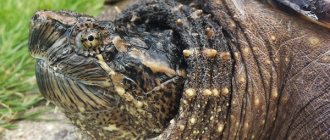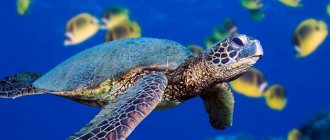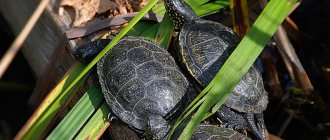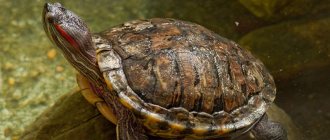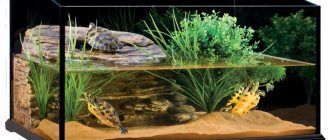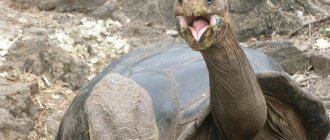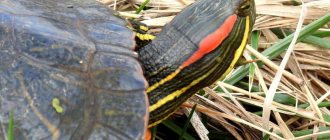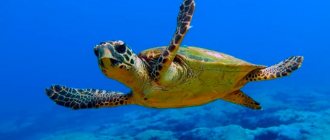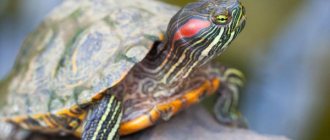Author: Demid
23 May 2016 19:40
Tags: animal misconceptions facts turtles
2772
11
Since childhood, our idea of the world has been formed from the stories of adults - parents and grandparents, from books, from television shows. Unfortunately, adults only tell us what they know themselves. And this information is not always correct and truthful. Various fairy tales and cartoons show us a distorted reality, which, although it teaches us goodness and justice, does not show the true essence of things.
How fast do land and sea turtles run and swim?
In the folklore of the countries of the former Soviet Union, the image of a turtle is inextricably linked with slowness. On the Fiji Islands, the reptile, on the contrary, is a symbol of speed. Residents respect these animals for their impeccable orientation skills and the swiftness that the reptiles display in the water.
Factors that affect the speed of movement of a turtle:
The length of the limbs in representatives of species capable of hiding their paws and head under their shell is shorter, so their dynamics are significantly lower than in those species that cannot do this (big-headed turtle, snapping turtle, sea turtles).
The speed of a turtle on land is lower than in water.
Dream Interpretation – Poisonous snake
In general, a negative, destructive, dangerous force, including a sexual symbol. The disease bit me. Seeing an insidious dangerous woman; evil; treason. The acquisition of secret knowledge is caressed in a friendly manner; a flattering but cunning lover. Sometimes it expresses the hidden mystical energy in a person, called Kundalini, and in connection with this the danger of demonic temptation by supernatural abilities and departure from love. A tangle of snakes, painful internal contradictions. White touches dangerous, destructive knowledge. Water is a danger associated with the past. Killing a snake is very good.
Travel speed on land
Reptiles whose paws look more like flippers walk with less comfort, but not always slower. In comfortable circumstances, the reptile prefers to crawl slowly. An increase in pace occurs if the animal feels danger or is seriously interested in some object at a distance. To run, in the full sense of the word, i.e. At some point, the reptile cannot avoid touching the ground. But if necessary, they can speed up significantly.
Soft-bodied turtles run fast. Due to weak ossification and the flat shape of the shell, they are able to rapidly accelerate to high speeds. The maximum speed of a turtle on land is 15 km/h.
Video: how fast a water turtle runs on land
Juveniles are faster than adults, and their lives depend on this in the wild.
Marine breeds feel constrained on land due to the structure of their paws, which are more reminiscent of flippers. They are significantly inferior in walking speed to freshwater species, but will pose serious competition to land species.
The land turtle's speed is often slower than that of freshwater species. There is no need to catch up with plant food, so evolution chose the shell as the priority means of defense. In case of danger, it is enough for them to hide their head and paws.
The maximum speed of a land turtle on average does not exceed 0.7 km/h. The officially recorded record was set by an individual of the leopard breed and is equal to 0.9 km/h.
The Seychelles giant tortoise is recognized as the slowest among land turtles. She can cover no more than 6.17 meters per minute, since her pace does not exceed 0.37 km/h.
Gopher and star tortoises run a little faster, about 0.13 m/s. In the same time they can cover 7.8 meters.
The average speed of a land turtle is 0.51 km/h.
Video: how fast a land turtle moves
Owners of Central Asian land dogs note that their pets are active and energetic. The Central Asian land tortoise can travel 468 meters in an hour. Its speed does not exceed 12 cm/s. Unfavorable soil is not a problem for the reptile. Steep slopes and loose materials underfoot cannot prevent her from moving forward.
Animal protection
The greatest harm to turtles in the entire history of their existence on Earth was caused by humans. There are known periods when animals were massacred for meat, shell or other body parts. When sailors set sail, they took dozens of live turtles on board the ship. The animals did not require special care and feeding, and, if necessary, served as a source of dietary meat.
To prepare some traditional medicine recipes, turtle body parts or their waste products are required. This circumstance also caused the unauthorized capture of animals, which, in turn, negatively affected the population.
Man's predatory attitude towards reptiles has led not only to a reduction in their numbers, but also to the threat of extinction of animals. Urgent action was required to avoid the extinction of many species. Half of all turtle species on Earth are currently at risk of extinction.
Movement speed in water
Land species can survive in water for some time, but many individuals cannot swim. A long stay outside of their native elements is dangerous for animals. Paws without membranes and an elongated tuberous shell structure are not intended for racing in bodies of water.
Freshwater turtles have membranes between their toes, and the shell is low and smooth. This allows them to develop at an impressive pace. Dynamics contributes to successful hunting of fish and aquatic animals.
Large leatherback turtles swim at speeds 14 times faster than a Greenland shark and about as fast as a whale shark.
The speed of sea turtles in the water is high, as the streamlined, oval shell and flipper-shaped forelimbs are very helpful at depth. On average, they are superior to freshwater species in this.
Examples of swimming speed for marine rocks:
How fast a turtle swims depends not only on its physical characteristics. The possibilities are influenced by the direction of the current, the density and temperature of the water.
Video: swimming with a turtle
Setting up a home for a turtle
In order for the new tenant to feel cozy and comfortable with you, you should first of all take care of a comfortable home. An aquaterrarium is the most suitable housing for freshwater reptiles. The red-eared turtle will feel comfortable and cozy in such a container. The size of the aquarium should be sufficient to hold 150-200 liters of water. It must be changed at least once a month, after letting it sit for five days. To keep your aquarium clean, it is advisable to purchase a water filter.
The peculiarities of the existence of a freshwater turtle require the presence of a small piece of land nearby. Artificial islands with gentle banks can be freely purchased at a pet store. It is desirable that the slope has a rough, uneven surface, then the reptile can freely get out onto land.
The turtle loves warmth very much, so it is necessary to arrange an artificial sun for it, which will well illuminate the top of the island and warm the air at its surface to 30-31 o C. To maintain a comfortable water temperature (from 24 to 26 o C), install an adjustable incandescent lamp .
It is desirable that the container for keeping reptiles has an elongated rectangular shape. The size of an aquarium for a red-eared turtle with a shell length of 25 cm can have the following approximate indicators:
- volume - 150 l;
- length - 1000 mm;
- width - 500 mm;
- height - 900 mm;
- water depth - 500 mm;
- island length - 250 mm;
- island width - 120 mm.
Despite their deceptive slowness, reptiles are actually very agile. Therefore, when arranging sushi, you should position it so that the distance from the top to the edge of the glass wall is at least 30-35 cm. The proposed container parameters are optimal for one adult red-eared turtle to comfortably fit in it. It is not always possible to maintain the dimensions at home due to lack of free space in the apartment. For comfortable living of two adults, you will need an aquaterrarium with a capacity of at least 180-200 liters.
Speed of red-eared turtles
In its natural habitat, the diet of the red-eared beauty consists of 40% protein. Shellfish and small fish are eaten. On average, river fish maintain a speed of 0.3 m per minute, and can reach 2 m/s, which does not interfere with the reptile’s hunting. Turtles swim at a speed of 5-7 km/h, and the maximum speed of the red-eared slider can exceed these figures.
On land, the red-eared turtle is slightly inferior to its own records in water bodies. When in danger, the animal tends to hide in the nearest source of water, where it feels more confident.
The red-eared turtle is the leader in mobility among its sister species. She can cover several kilometers a day. Combined with a good reproductive system, this allows the reptile to quickly explore new territories and compete with their inhabitants. The red-eared slider is on the official IUCN list of the “Top 100 Invasive Species.”
Video: how a red-eared turtle hunts fish
Source
Balanced diet
In nature, red-eared turtles feed not only on plant foods, but also on animal foods.
Therefore, at home it is very important to organize for them a balanced diet that corresponds to the natural composition. For active growth, turtles require a lot of protein, so they must be fed animal food once a day.
Young individuals are given dry fish food, earthworms, bloodworms, woodlice, and sea crustaceans (dried or live).
An adult red-eared turtle, whose size (photo below) exceeds 10-12 cm, can eat liver, raw or boiled beef, and chicken. It is also useful to treat her to raw low-fat fish, squid, and shrimp. You can add several small fish into the aquarium so that the turtle hunts them itself. Various insects (beetles and larvae) should definitely be included in the freshwater menu. For convenience, you can prepare a mixture of several gelatin-based foods with the addition of raw chicken eggs. The finished composition can be stored in the refrigerator for a long time.
As reptiles grow, plant foods should be introduced into their diet. In the aquarium, aquatic plants are bred that the turtle can eat: algae, duckweed, water hyacinth, edogonium, ludwigia and some others. Turtles happily eat fresh greens: mallow, basil, dandelions, clover, peas. For vegetables, you can give pieces of carrots, fresh cucumber, white cabbage, and lettuce. Bone meal is an essential source of calcium, which is required for skeletal growth and shell strengthening. Once a week it should be added to the turtles' food. From time to time it is useful to add a couple of drops of vitamin D oil solution to your food.
If it is not possible to create ideal living conditions for the turtle and organize proper nutrition, you should take care to introduce mineral supplements and vitamin supplements into the diet.
Feeding is carried out during the daytime, since freshwater animals are most active during this period of the day. Everything is simply poured into water. Food must be given little by little so that the animals have time to eat it. Excess food will settle to the bottom and, rotting, pollute the water in the aquarium. Young animals are fed daily, but adults need to be given food 2-3 times a week.
Maximum speed of a turtle on land and in water
The speed at which a turtle moves is determined by its species and age. A young turtle is much slower than an old one, not only when swimming, but also when walking. The countries of the former USSR in their folklore inextricably link the image of this animal with slowness. But on the island of Fiji, on the contrary, it symbolizes speed. This reptile commands respect among the inhabitants of the island, possessing impeccable skills of orientation and swiftness, which it demonstrates in the water.
The speed of a turtle depends on several factors:
Some turtles can hide their heads and limbs under their shells because they are short, which is the reason for their significantly lower dynamics compared to those species that are not allowed to do this. In particular, we are talking about big-headed, vulture and sea turtles.
Running speed on land
It is not so comfortable for individuals with paws resembling flippers to walk, although this does not always affect their speed. In comfortable conditions, it is preferable for a reptile to crawl slowly. The animal will increase its pace if it senses danger or is seriously interested in some object located in the distance. The reptile cannot run as such, but if necessary, it can speed up significantly. The soft-bodied breed of turtles is distinguished by its fast running. Weak ossification and the flat shape of the shell allow them to rapidly develop speed and achieve high speeds.
A turtle can move on land at a maximum speed of 15 km/h. Marine breeds are not comfortable on land due to the structure of their paws, which are more like flippers. They are in many ways inferior in speed to freshwater turtles, although they can seriously compete with land turtles.
A land turtle is often slower than a freshwater turtle. It does not chase plant food, and therefore evolution has provided it with a shell as a priority means of defense. If she feels danger, she can always completely hide in it. The land turtle can reach a top speed of more than 0.7 km/h. The record holder among turtles was an individual of the leopard breed, which “ran” up to 0.9 km/h.
Running speed in water
Land reptiles can stay in water for some time, but many individuals are not able to swim. The turtle's maximum speed is up to 40 km/h
Animals will be in danger if they are away from their native elements for a long time. With unwebbed paws and elongated tuberous shells, turtles cannot move quickly in bodies of water. The freshwater turtle has webbing between its toes and a smooth shell. Thanks to this, it is developing at an impressive pace. The dynamics allow you to successfully hunt fish and other aquatic life. The large leatherback turtle can swim 14 times faster than the Greenland shark and about as fast as the swift whale.
One thing is clear: we must love and protect the animal world!
Source
Sloths
These animals fully justify their name. Even if they want to get down from the branch, sloths do not slide down the trunk, but simply fall down. On the ground, sloths literally crawl on their bellies at a speed of about 150 meters per hour. However, many of them are good swimmers, reaching speeds of up to 4 km/h in the water.
Are you tired of images of a lean lion rushing after a springing gazelle and muscular jaguars outrunning the wind? Yes, all these animals are capable of moving very quickly, everyone knows this. But why not look at the other side of the coin? Let's turn our gaze to a world of calm and thoughtfulness. Which animals in the wild are the slowest?
garden snail
It is not surprising that the simple garden snail, familiar to most of us, has the status of the slowest moving animal in the world. The maximum speed of its movements reaches 1.3 centimeters per second (78 cm per minute or 47 meters per hour). This means that it will take her 21 hours to walk a kilometer. Hmm... some plants grow faster than this creature can move!
Sloth
The slowest animal in the world is also recognized by many people as one of the most charming creatures living on our planet: just look how cute he is! If the sloth sets out to move, he can reach a speed of a maximum of 2 m per minute, that is, 0.12 km/h. Really, what's the rush?
Starfish
It's hard to imagine, but it's a fact - some species of starfish move faster than sloths and snails. There are about 1,500 species of starfish in the world, and most of them are not particularly good at moving quickly. The species Dermasterias imbricata can move at a speed of only 15 cm per minute, but Luidia foliolata, called the sand starfish, is capable of traveling at a lightning speed for its fellows at 2.8 m per minute (0.168 km/h).
Giant turtle
The giant tortoise occupies a confident position as a leader among the slowest reptiles, and is also one of the slowest animals on the planet. However, given a life expectancy of 190 years, we can assume that these calm guys are in no hurry. And besides, who would not prefer to slow down when weighing an impressive 300 kg?
Koala
Koala marsupials are of Australian origin and, like sloths, are extremely cute and incredibly slow. Why do they need to rush? There are enough eucalyptus leaves for everyone!
Slug
Slugs give the impression of naked or deprived snails. They move, like their “stay-at-home” relatives, more than sedately. In the entire history of scientists observing the breathtakingly rich life of slugs, the maximum recorded speed of movement was 0.3 km/h.
Sea Horse
There are 54 species of skates on Earth. The size of these creatures ranges from 1.5 to 35.5 cm. Seahorses swim in an upright position, and they do it very poorly: slower than the most leisurely inhabitants of the water element. Their maximum speed is about 1.5 m per hour, and this fact allows us to call seahorses the slowest fish on the planet.
Arizona snaketooth
This cute monster is also known as the Gila Monster. The size of such a large reptile can reach 60 cm, and the weight is usually from 350 to 700 g. The poisonous lizard is the only venomous lizard native to the United States and one of two known species of venomous lizards in North America. But for humans, Gila does not pose much of a threat, since it moves incredibly slowly.
Manatee
Manatees or sea cows are marine mammals. Their size reaches 4 m in length, and they sometimes weigh as much as 590 kg. To move such an impressive weight in the water column is a paddle-shaped tail and flippers that are quite modest compared to the volume of the body. It is not surprising that these quiet people are not particularly fast.
Maximum speed of a turtle on land and in water
The speed at which a turtle moves is determined by its species and age. A young turtle is much slower than an old one, not only when swimming, but also when walking. The countries of the former USSR in their folklore inextricably link the image of this animal with slowness. But on the island of Fiji, on the contrary, it symbolizes speed. This reptile commands respect among the inhabitants of the island, possessing impeccable skills of orientation and swiftness, which it demonstrates in the water.
The speed of a turtle depends on several factors:
Some turtles can hide their heads and limbs under their shells because they are short, which is the reason for their significantly lower dynamics compared to those species that are not allowed to do this. In particular, we are talking about big-headed, vulture and sea turtles.
Running speed on land
It is not so comfortable for individuals with paws resembling flippers to walk, although this does not always affect their speed. In comfortable conditions, it is preferable for a reptile to crawl slowly. The animal will increase its pace if it senses danger or is seriously interested in some object located in the distance. The reptile cannot run as such, but if necessary, it can speed up significantly. The soft-bodied breed of turtles is distinguished by its fast running. Weak ossification and the flat shape of the shell allow them to rapidly develop speed and achieve high speeds.
A turtle can move on land at a maximum speed of 15 km/h. Marine breeds are not comfortable on land due to the structure of their paws, which are more like flippers. They are in many ways inferior in speed to freshwater turtles, although they can seriously compete with land turtles.
A land turtle is often slower than a freshwater turtle. It does not chase plant food, and therefore evolution has provided it with a shell as a priority means of defense. If she feels danger, she can always completely hide in it. The land turtle can reach a top speed of more than 0.7 km/h. The record holder among turtles was an individual of the leopard breed, which “ran” up to 0.9 km/h.
How do they reproduce?
The age of puberty depends on the size of the individuals. The smallest reptiles are ready to reproduce at 2 years of age; giant reptiles mature at 10-12 years and later. Regardless of the species and habitat conditions, turtle reproduction has several common features:
- during the mating season, skirmishes occur between males, during which rivals try to turn each other over or bite each other with a strong beak;
- before mating, males court females by stroking them with their forelimbs and making primitive sounds;
- all turtles are oviparous animals, the formation of eggs after fertilization occurs within 2-3 months, some females are able to retain the sex cells of the male in the body and make several repeated clutches per season;
- females choose places for laying so that the eggs warm up under the sun's rays; they dig holes for laying eggs themselves or use crocodile ones;
- The sex of the cubs is determined during the developmental stage and depends on temperature.
All turtles, with the exception of a few species, do not return to them after laying eggs and do not take part in protecting and raising their offspring. Turtles are born after 2-3 months; in larger species, the incubation process lasts up to six months. The hatched babies crawl towards the water. Many of them die, becoming food for birds of prey and animals.
Maximum speed of a turtle.
Turtles are living fossils of our planet. The beginning of the creation of the world is associated with the turtle. Thus, according to ancient ideas, the Earth rested on the back of a gigantic turtle, which swam across the World Ocean or stood on something, for example, on elephants. Most people associate the turtle with clumsiness and slowness. But this does not apply to all representatives of this species.
Among the 220 species of turtles that exist, the fastest is the leatherback turtle. Its maximum speed in water reaches 35 km/h, and it is also the best diver among turtles. The body weight of this turtle can reach up to 450 kg, and its body length is usually about 2 m. On land, it can move at a speed of no more than 15 km/h. Semi-aquatic turtles, such as the red-eared turtle, move faster on land. In terms of speed, it can quite confidently compete with some types of fish, and on land it is also quickly capable of avoiding obstacles in its path and hiding from its pursuers. But sea and large land turtles move slowly. This is due to the structure of their body: the weight of the shell and the length of the limbs. Turtles, whose limbs and head can be retracted into their shells, have short limbs, so they move slowly and are a symbol of clumsiness, slowness and baggyness.
If we open up the question “Who is faster, a turtle or a snail?”, then we can say that the maximum speed of a snail is about 7 cm/min, which is equal to approximately 0.004 km/h, this is with an average snail size. For an objective assessment, we need to equate the sizes of the turtle and the snail. In the time it takes a snail to travel a distance equal to the length of the snail, the turtle travels a distance equal to ten turtle lengths. This proves that a turtle is faster than a snail.
Over the past centuries, the numbers of some turtle species have reached critical levels. Thousands of sea turtles were released into turtle soup, and almost all the turtles of the Galapagos archipelago were destroyed because... sailors took them with them on voyages as “live canned food”, because these reptiles can live for quite a long time without food and water.
Nowadays, turtles are protected, and many of their species are listed in the Red Book. After all, turtles are the oldest inhabitants of our planet, who keep so many mysteries and mysteries that have not yet been solved by humanity!
Poinsettia: how to care for a Christmas plant at home?
The New Year is inexorably approaching, which means that along with Christmas trees, flower shops will be actively offering Christmas flowers to everyone. Poinsettia is considered a symbol of the New Year holidays and is perfect as a decoration for the holiday home. At the same time, few manage to keep this beauty at home. What to do, how to care for the plant? Let's talk.
Bamboo for the home: can you grow it on your windowsill?
A gift from nature: what are the benefits of blackcurrant leaves?
Black currant leaves are an excellent and very useful gift from nature. Using currant leaves, you can prepare various medicinal infusions, make preparations and even cosmetics. This post will talk about the entire spectrum of beneficial effects of blackcurrant leaves.
Meristem crops: what is it and what is it eaten with?
Today, very often in the price list opposite the name of plants you can see the mark “meristematic”. And as a rule, misunderstanding of this term pushes people to doubt, considering it more a disadvantage than an advantage. This material will tell you what meristem plants are and what makes them special.
Who wins
From the above figures it becomes clear that absolutely any turtle can easily outrun a snail, even the most nimble one
True, zoologists also focus on the size of these two species. If a snail were scaled to the size of a reptile, then the speed of their movement would be approximately the same
So easily, with the help of calculations, the question of who will overtake whom - a turtle and a snail or vice versa - was resolved.
—>
Slug
Slugs give the impression of naked or deprived snails. They move, like their “stay-at-home” relatives, more than sedately. In the entire history of scientists observing the breathtakingly rich life of slugs, the maximum recorded speed of movement was 0.3 km/h.
Sea Horse
There are 54 species of skates on Earth. The size of these creatures ranges from 1.5 to 35.5 cm. Seahorses swim in an upright position, and they do it very poorly: slower than the most leisurely inhabitants of the water element. Their maximum speed is about 1.5 m per hour, and this fact allows us to call seahorses the slowest fish on the planet.
Arizona snaketooth
This cute monster is also known as the Gila Monster. The size of such a large reptile can reach 60 cm, and the weight is usually from 350 to 700 g. The poisonous lizard is the only venomous lizard native to the United States and one of two known species of venomous lizards in North America. But for humans, Gila does not pose much of a threat, since it moves incredibly slowly.
Manatee
Manatees or sea cows are marine mammals. Their size reaches 4 m in length, and they sometimes weigh as much as 590 kg. To move such an impressive weight in the water column is a paddle-shaped tail and flippers that are quite modest compared to the volume of the body. It is not surprising that these quiet people are not particularly fast.
American woodcock
The American woodcock is considered the slowest bird in the world. While it is certainly much faster than the rest of the animals on this list, the woodcock holds the record for the slowest bird flight ever recorded by science at 8 km/h.
Share the post with your friends!
How fast do land and sea turtles run and swim?
In the folklore of the countries of the former Soviet Union, the image of a turtle is inextricably linked with slowness. On the Fiji Islands, the reptile, on the contrary, is a symbol of speed. Residents respect these animals for their impeccable orientation skills and the swiftness that the reptiles display in the water.
Factors that affect the speed of movement of a turtle:
The length of the limbs in representatives of species capable of hiding their paws and head under their shell is shorter, so their dynamics are significantly lower than in those species that cannot do this (big-headed turtle, snapping turtle, sea turtles).
The speed of a turtle on land is lower than in water.
Features of maintenance and care
You can keep several turtles in the house separately or together.
When housing in a group, it is important that the animals have enough space to move freely. Turtles often get dirty in the soil that is poured on the bottom of the aquarium; food debris sticks to their faces
You need to keep your turtles clean by regularly bathing them in warm water with baking soda added. Algae that periodically grows on the shell should be carefully cleaned off with a soft sponge.
When caring for a turtle, you need to be careful because it can bite painfully. Individuals of the same size living in the same territory usually coexist peacefully with each other. When the aquarium contains one, its size does not matter. But when there are several reptiles in a group, you need to remember that large ones can bite and even cripple those who are smaller than them.
Interesting facts about turtles
Special literature contains many amazing facts from the life of turtles. For example, some species that live in water bodies are able to hold their breath for ten hours. This is a record for a group of vertebrates. Among the representatives of different species of turtles there are animals with aggressive habits. Snapping turtles can watch for waterfowl and snakes. There are known cases of them attacking humans. A large animal can become a victim of a flock of hungry reptiles.
The world of turtles is incredibly diverse. There are species that can go without food for a long time. For example, an elephant turtle can fast for eighteen months.
Reptiles inhabit all continents of the Earth. Turtles are not found only in Antarctica. All species require a warm environment to reproduce. Published interesting facts about turtles always contain material telling about the behavior of animals during reproduction. During this period, they are able to travel great distances. Young reptiles behave in a similar way.
Turtles are easily tamed and live close to humans. It became known that such animals can clearly distinguish the faces of the people who care for them. In this case, the appearance of a person is perceived visually, and not at the chemical level. In addition, turtles distinguish the intonation of human voices. When it sounds calm and gentle, the turtle stretches its head and listens to the sounds. When shouting or hearing a sharp or loud voice, turtles pull their heads under their shell.
Some species are excellent divers. Cases of animals penetrating to a depth of about 1200 meters have been recorded. Turtles have also been in space. The scientists’ choice was justified by the fact that these animals can go without food for a long time, use a small amount of oxygen for breathing, and hibernate under unfavorable conditions.
Prehistoric species
Among the descriptions of ancient turtle species, the most common are those that inhabited the Earth 220 million years ago. Extinct species that lived on the planet in a later period are also known. Their distinctive feature is that the turtle shell was only in the lower part of the body. Prehistoric animals had teeth; modern species do not.
The size of the reptiles is also impressive. Scientists have found that the largest turtle that ever existed on Earth supposedly measured about two meters in diameter and weighed more than two tons. The data was established by scientists thanks to the found skeleton of an ancient turtle. This turtle ancestor was given the name Archelon.
Travel speed on land
Reptiles whose paws look more like flippers walk with less comfort, but not always slower. In comfortable circumstances, the reptile prefers to crawl slowly. An increase in pace occurs if the animal feels danger or is seriously interested in some object at a distance. To run, in the full sense of the word, i.e. At some point, the reptile cannot avoid touching the ground. But if necessary, they can speed up significantly.
Soft-bodied turtles run fast. Due to weak ossification and the flat shape of the shell, they are able to rapidly accelerate to high speeds. The maximum speed of a turtle on land is 15 km/h.
Video: how fast a water turtle runs on land
Juveniles are faster than adults, and their lives depend on this in the wild.
Marine breeds feel constrained on land due to the structure of their paws, which are more reminiscent of flippers. They are significantly inferior in walking speed to freshwater species, but will pose serious competition to land species.
Lifespan
The turtle can rightfully be considered one of the planet's longest-livers. There are cases when the life expectancy of individual individuals was 250 years. Most turtles in the wild live a little over a hundred years—an age that is also quite impressive.
To find out how old a turtle is, you need to look closely at its shell. The concentric arrangement of rings on the scutes will indicate the number of years the animal has lived. The method for determining the age of a turtle is similar to that used to determine the age of woody plants - by the growth rings on the trunk.
Movement speed in water
Land species can survive in water for some time, but many individuals cannot swim. A long stay outside of their native elements is dangerous for animals. Paws without membranes and an elongated tuberous shell structure are not intended for racing in bodies of water.
Freshwater turtles have membranes between their toes, and the shell is low and smooth. This allows them to develop at an impressive pace. Dynamics contributes to successful hunting of fish and aquatic animals.
Large leatherback turtles swim at speeds 14 times faster than a Greenland shark and about as fast as a whale shark.
The speed of sea turtles in the water is high, as the streamlined, oval shell and flipper-shaped forelimbs are very helpful at depth. On average, they are superior to freshwater species in this.
Examples of swimming speed for marine rocks:
How fast a turtle swims depends not only on its physical characteristics. The possibilities are influenced by the direction of the current, the density and temperature of the water.
Video: swimming with a turtle
Reaction
The slow speed of a snail's movement does not mean that it lacks a quick reaction. There are varieties of tropical mollusks (the cone family, for example) whose heavy shells prevent them from moving at relatively high speeds. At the same time, the snail is a good “hunter”. She can grab a small fish, worm or smaller mollusk with lightning speed without “moving from the spot” thanks to her excellent reaction.
As soon as the cone snail notices prey, it begins to slowly extend its proboscis and, seizing an opportune moment, “shoots” poison at its victim, which, in the form of a harpoon, reaches the target in 200 - 300 milliseconds.
The Australian naticide Conuber sordidus is capable of very quickly grabbing a crab with its “leg” and then eating it alive.
What determines the speed of amphibians?
The ability to run fast is determined by the weight of the shell and body temperature. The colder and heavier the animal's body, the slower it will move. It’s amazing how the Central Asian red-eared turtle runs. These freshwater animals, in a moment of danger or discomfort, can quickly retreat to a secluded place, which disproportionately surprises their owners.
The speed at which turtles run depends on their natural environment. Let's say reptiles living in the sea behave very clumsily on land, but in water they move quickly and easily. Land turtles are slower and only become active if it is very hot outside. Their body acquires a normal temperature, and all processes in the body go faster, which “awakens” the reptiles, making them as energetic as warm-blooded animals.
Carapace
When listing interesting facts about turtles, one cannot help but pay attention to such a feature of the structure of the animal’s body as the shell. This armor is reliable protection in many adverse situations, since the shell is able to withstand a weight exceeding the mass of the reptile itself by two hundred times. It became known that the shell of a turtle is riddled with nerve endings, thanks to which the animal can respond to changes in the environment.
In moments of danger, the turtle retracts its head and limbs, as a result of which they are covered with a shell. It is rare that a predator manages to reach an animal hidden in a shelter.
Speed of red-eared turtles
In its natural habitat, the diet of the red-eared beauty consists of 40% protein. Shellfish and small fish are eaten. On average, river fish maintain a speed of 0.3 m per minute, and can reach 2 m/s, which does not interfere with the reptile’s hunting. Turtles swim at a speed of 5-7 km/h, and the maximum speed of the red-eared slider can exceed these figures.
On land, the red-eared turtle is slightly inferior to its own records in water bodies. When in danger, the animal tends to hide in the nearest source of water, where it feels more confident.
The red-eared turtle is the leader in mobility among its sister species. She can cover several kilometers a day. Combined with a good reproductive system, this allows the reptile to quickly explore new territories and compete with their inhabitants. The red-eared slider is on the official IUCN list of the “Top 100 Invasive Species.”
Definition of terms
1.1 The following terms are used in this Privacy Policy:
1.1.1. “Site Administration” (hereinafter referred to as the Administration) - authorized employees to manage the Otmetka website, who organize and (or) carry out the processing of personal data, and also determine the purposes of processing personal data, the composition of personal data to be processed, actions (operations) performed with personal data.
1.1.2. “Personal data” – any information relating to a directly or indirectly identified or identifiable individual (subject of personal data).
1.1.3. “Processing of personal data” – any action (operation) or set of actions (operations) performed using automation tools or without the use of such means with personal data, including collection, recording, systematization, accumulation, storage, clarification (updating, changing), extraction, use, transfer (distribution, provision, access), depersonalization, blocking, deletion, destruction of personal data.
1.1.4. “Confidentiality of personal data” is a mandatory requirement for the Operator or other person who has access to personal data to not allow their distribution without the consent of the subject of personal data or the presence of another legal basis.
1.1.5. “Otmetka Site” is a collection of interconnected web pages located on the Internet at a unique address (URL): otmetka.tv, as well as its subdomains.
1.1.6. “Subdomains” are pages or a set of pages located on third-level domains belonging to the Otmetka website, as well as other temporary pages, at the bottom of which the Administration’s contact information is indicated
1.1.5. “User of the Otmetka website” (hereinafter referred to as the User) is a person who has access to the Otmetka website via the Internet and uses information, materials and products of the Otmetka website.
1.1.7. “Cookies” are a small piece of data sent by a web server and stored on the user’s computer, which a web client or web browser sends to the web server each time in an HTTP request when an attempt is made to open a page on the corresponding site.
1.1.8. “IP address” is a unique network address of a node on a computer network through which the User gains access to the Reviews Site.
Separatists abandoned the videoconference format
December 20, 2022, 10:40
Donbass separatists refused to hold a videoconference on December 20, during which it would be possible to agree on an exchange of prisoners. As DPR representative Natalya Nikonorova stated, the Ukrainian side is seeking PR and will not have time to do anything in such a short time.
Separatists put forward an ultimatum to Ukraine
On December 17, Donbass separatists held a joint briefing at which they made a statement: the Ukrainian leadership is obliged to coordinate all issues regarding the implementation of the Second Minsk Agreements with the leaders of the quasi-republics. According to Pushilin and Pasechnik, otherwise Ukraine must admit its inability to negotiate.
1 December 17, 2022, 18:51
Separatists announced new territorial appetites
Donbass separatists suddenly adopted a law on the “state border”, trying to expand the borders of the self-proclaimed DPR to the entire territory of the Donetsk region. This is reported by separatist and Russian media. According to the representative of the “Donetsk parliament” Vladimir Bidevka, such a decision does not contradict Minsk-2.
1 30 November 2022, 10:10
Sivokho spoke about reconciliation with Donbass
According to the Ukrainian showman and adviser to the head of the National Security and Defense Council Sergei Sivokho, Ukraine must mentally return the residents of Donbass. The liberation of the occupied individual areas of the Donetsk and Lugansk regions must be carried out according to a clear plan, which was voiced by Sivokho.
0 15 November 2022, 13:52
